Solar eclipse of December 15, 2039
| Solar eclipse of December 15, 2039 | |
|---|---|
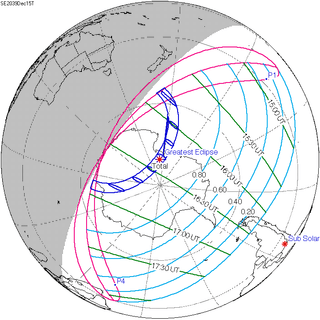 Map | |
| Type of eclipse | |
| Nature | Total |
| Gamma | -0.9458 |
| Magnitude | 1.0356 |
| Maximum eclipse | |
| Duration | 111 sec (1 m 51 s) |
| Coordinates | 80°54′S 172°48′E / 80.9°S 172.8°E |
| Max. width of band | 380 km (240 mi) |
| Times (UTC) | |
| Greatest eclipse | 16:23:46 |
| References | |
| Saros | 152 (14 of 70) |
| Catalog # (SE5000) | 9596 |
A total solar eclipse will occur on December 15, 2039. A solar eclipse occurs when the Moon passes between Earth and the Sun, thereby totally or partly obscuring the image of the Sun for a viewer on Earth. A total solar eclipse occurs when the Moon's apparent diameter is larger than the Sun's, blocking all direct sunlight, turning day into darkness. Totality occurs in a narrow path across Earth's surface, with the partial solar eclipse visible over a surrounding region thousands of kilometres wide.
The totality of the eclipse begins in the southern Pacific Ocean, passing over much of Antartica and closely reaching the South Pole. A partial eclipse will be visible in the southern extremities of South America and Africa. It will terminate in the southern Indian Ocean several hours later.[1]
Images
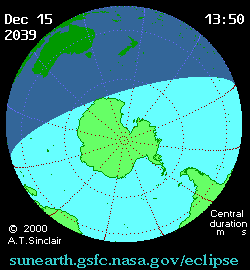
Animated path
Related eclipses
Solar eclipses of 2036-2039
This eclipse is a member of a semester series. An eclipse in a semester series of solar eclipses repeats approximately every 177 days and 4 hours (a semester) at alternating nodes of the Moon's orbit.[2]
Note: Partial lunar eclipses on February 27, 2036 and August 21, 2036 occur on the previod lunar year eclipse set.
| Solar eclipse series sets from 2036-2039 | ||||
|---|---|---|---|---|
| Ascending node | Descending node | |||
| 117 | July 23, 2036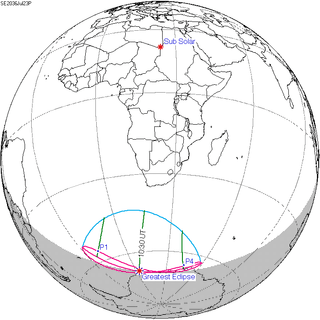 Partial |
122 | January 16, 2037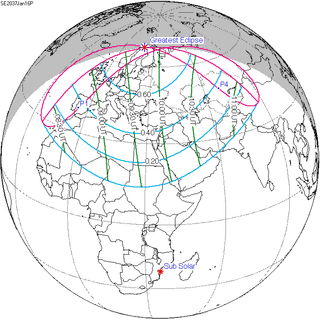 Partial | |
| 127 | July 13, 2037 Total |
132 | January 5, 2038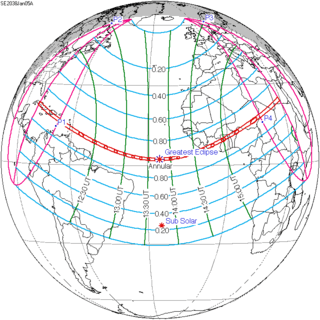 Annular | |
| 137 | July 2, 2038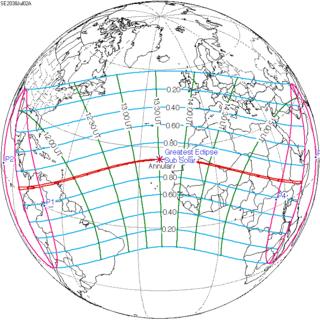 Annular |
142 | December 26, 2038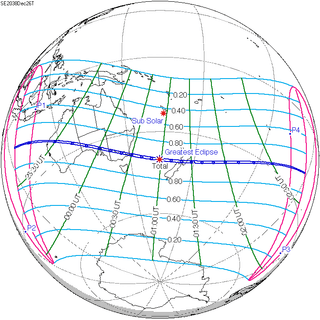 Total | |
| 147 | June 21, 2039 Annular |
152 | December 15, 2039 Total | |
Metonic cycle
The metonic series repeats eclipses every 19 years (6939.69 days), lasting about 5 cycles. Eclipses occur in nearly the same calendar date. In addition, the octon subseries repeats 1/5 of that or every 3.8 years (1387.94 days).
| 21 events between July 22, 1971 and July 22, 2047 | ||||
|---|---|---|---|---|
| July 21-22 | May 9-11 | February 26-27 | December 14-15 | October 2-3 |
| 116 | 118 | 120 | 122 | 124 |
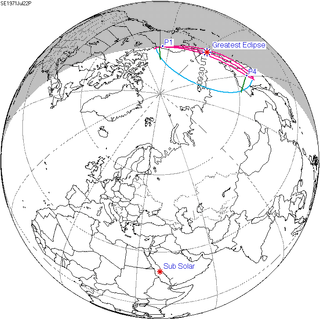 July 22, 1971 |
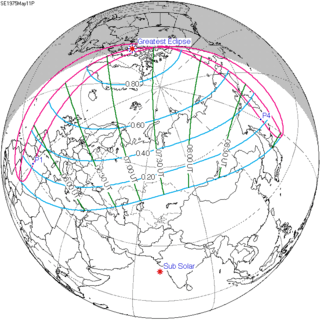 May 11, 1975 |
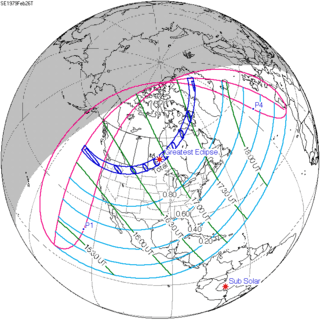 February 26, 1979 |
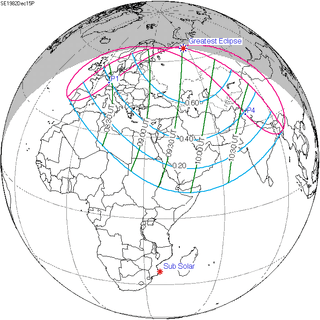 December 15, 1982 |
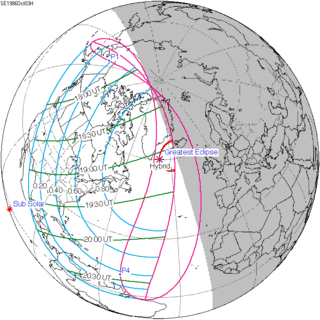 October 3, 1986 |
| 126 | 128 | 130 | 132 | 134 |
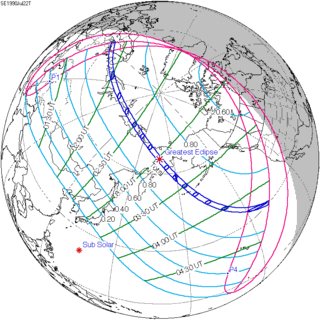 July 22, 1990 |
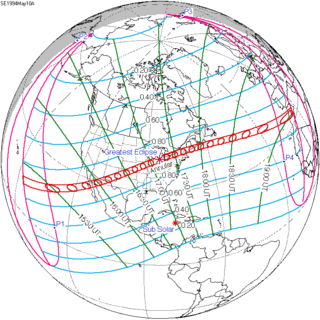 May 10, 1994 |
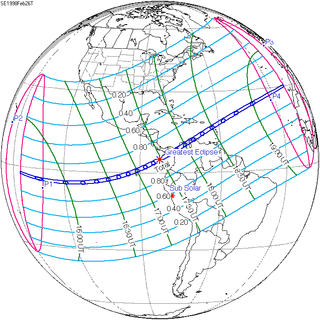 February 26, 1998 |
 December 14, 2001 |
 October 3, 2005 |
| 136 | 138 | 140 | 142 | 144 |
 July 22, 2009 |
 May 10, 2013 |
 February 26, 2017 |
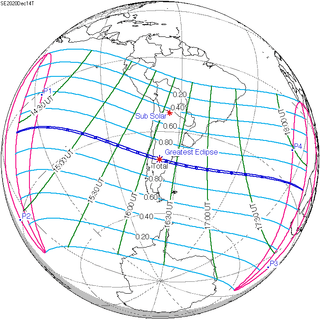 December 14, 2020 |
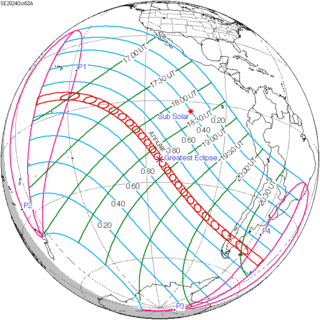 October 2, 2024 |
| 146 | 148 | 150 | 152 | 154 |
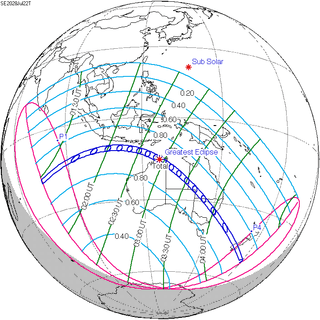 July 22, 2028 |
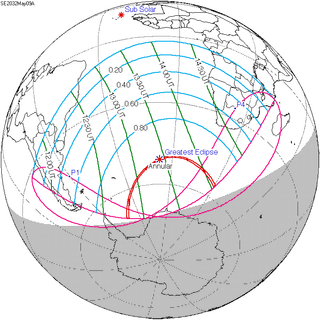 May 9, 2032 |
 February 27, 2036 |
 December 15, 2039 |
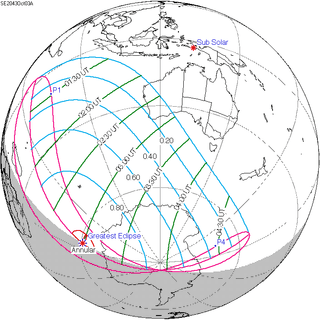 October 3, 2043 |
| 156 | ||||
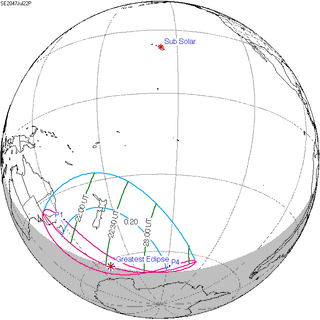 July 22, 2047 | ||||
References
- ↑ "Path of Total Solar Eclipse of 2039 Dec 15". NASA Goddard Space Flight Center Eclipse Website. NASA. Retrieved 9 September 2017.
- ↑ van Gent, R.H. "Solar- and Lunar-Eclipse Predictions from Antiquity to the Present". A Catalogue of Eclipse Cycles. Utrecht University. Retrieved 6 October 2018.
| Wikimedia Commons has media related to Solar eclipse of 2039 December 15. |
